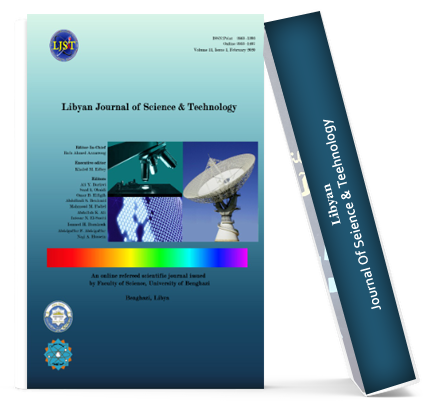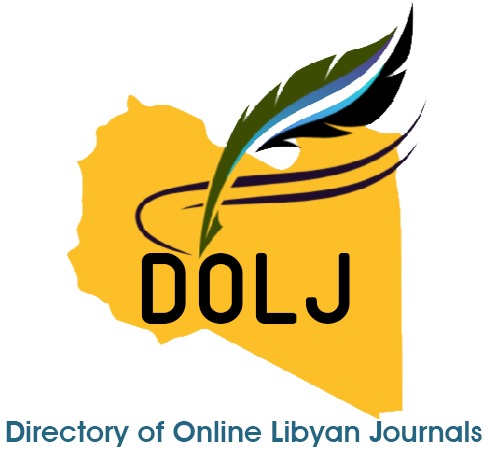Compost impact on heavy metals uptake of two crops; Hordeum vulgare L. and Vicia faba L
DOI:
https://doi.org/10.37376/ljst.v12i1.7062Keywords:
Compost, heavy metals uptake, Transfer ratio, Barley, Broad bean, Soil propertiesAbstract
Compost is a low-cost technology, environmentally friendly process used to treat organic waste. It has been shown to have several positive impacts when applied to soil on plant growth and some improvements on the physical and chemical properties of soil. It also controls the movements and uptake of metals by plants and animals. The plant species Hordeum vulgare L. (Barley) and Vicia faba L. (Broad bean) were used in this study. The organic fertilizer used was obtained from the local market. The results obtained showed that the application of compost in the soil had increased the growth of both Barley and Broad bean. The data obtained clearly illustrated that the compost used increased the concentration of some metals in the soil and plant especially Fe. But; the levels of heavy metals found in Barley and Broad bean were generally low and still below the permissible levels recommended by the Food Agriculture Organization (FAO) and the World Health Organization (WHO). Variations of the metals in the plants and soils were in the order of Fe>Zn>Ni. The Transfer Ratio (TR) of the metals from the soil to plants the values obtained found the following trend Fe>Ni>Zn.
Downloads
References
Abdel-Rahman, G. (2009) ‘Impact of compost on soil properties and crop productivity in the Sahel north Burkina Faso. American-Eurasian’, Journal of Agriculture and Environmental Sciences, 6(2), pp. 220-226.
Abou-Hussien, E., Elbaalawy, A. and Hamad, M. (2019) ‘Chemical properties of compost in relation to calcareous soil properties and its productivity of wheat’, Journal of Soil Science, 95(1), pp. 85-97.
Antonious, G., Dennis, S., Urine, J. and nyder, J. (2011) ‘Heavy metals uptake in plant parts of sweet potato growth in soil fertilized with municipal sewage sludge’, Journal of Geology, 5(1), pp. 14-20.
Bialobrzewski, I., Miks-Krajnik, M., Dach, J., Markowski, M., Czekala, W. and Gluchowska, K. (2015) ‘Model of the sewage sludge-straw composting process integrating different heat generation capacities of mesophilic and thermophilic microorganisms’, Waste Management, 43, pp. 72–83.
Bolan, N., Kunhikrishnan, A., Thangarajan, R., Kumpiene, J., Park, J., and Makino, T. (2014) ‘Remediation of heavy metal (loid)s con-taminated soils’, Journal of Hazardous Materials, 266, pp. 141–166.
Brown, P., Welch, R. and Cary, E. (1987) ‘Nickel: A micronutrient essential for higher plants’, Plant Physiology, 85, pp. 801-803.
Calleja-Cervantes, M., Fernandez-Gonzalez, A., Irigoyen, I., Fernán-dez-Lopez, M., Aparicio-Tejo, P. and Menendez, S. (2015) ‘Thir-teen years of continued application of composted organic wastes in a vineyard modify soil quality characteristics’, Soil Bi-ology and Biochemistry, 90, pp. 241-254.
Celik, I., Ortas, I. and Kilic, S. (2004) ‘Effect of compost, mycorrhiza, manure and fertilizer on some physical properties of achro-moxerert soil’, Soil and Tillage Research, 78(1), pp. 59-67.
Chefetz, B., Hatcher, P. G., Hadar, Y. and Chen, Y. (1996) ‘Chemical and biological characterization of organic matter during com-posting of municipal solid waste’, Journal of Environmental Quality, 25(4), pp. 776-785.
Chojnacka, K., Chojnacki, A., Gorecka, H. and Gorecki, H. (2005) ‘Bio-availability of heavy metals from polluted soils to plants’, Sci-ence of the Total Environment, 337, pp. 175-182.
Cui, Y., Zhu, Y., Zhai, R., Chen, D., Huang, Y., Qiu, Y. and Liang, J. (2004) ‘Transfer of metals from soil to vegetables in an area near a smelter in Nanning, China’, Environment International, 30, pp. 785-791.
De la Fuente, C., Clemente, R., Martinez-Alcala, I., Tortosa, G., and Pilar Bernal, M. (2011) ‘Impact of fresh and composted solid ol-ive husk and their water-soluble fractions on soil heavy metal fractionation; microbial biomass and plant uptake’, Journal of Hazardous Materials, 186(2-3), pp. 1283-1289.
FAO/WHO (2001). Joint FAO/WHO Food Standers Program, Codex Alimentarius Commission Contamination and food additives. ALINORM 01/12A, 1-289.
Fagnano, M., Adamo, P., Zampella, M. and Fiorentino, N. (2011) ‘En-vironmental and agronomic impact of fertilization with com-posted organic fraction from municipal solid waste: a case study in the region of Naples, Italy’, Agriculture, Ecosystems and Environment, 141(1-2), pp. 100-107.
Gonzalez, V., Garcia, I., Del Moral, F. and Simon, M. (2012) ‘Effec-tiveness of amendments on the spread and phytotoxicityof con-taminants in metal-arsenic polluted soil’, Journal of Hazardous Materials, 205, pp. 72-80.
Gray, C., Mclaren, R., Roberts, A. and Condron, L. (1999) ‘Cadmium phytoavailability in some New Zealand soils’, Australian Journal of Soil Research, 37, pp. 461-477.
Harrison, R., and Chirgawi, M. (1989) ‘The assessment of air and soil as contributors of some trace metals to vegetable plants. Use of a filtered air growth cabinet’, Science Total Environment, 83, pp.13-34.
Hatam, Z., and Ronaghi, A. (2012) ‘Influence of Compost and Com-post Leachate on Growth and Chemical Composition of Barley and Bioavailability of Some Nutrients in Calcareous Clay Loam Soil and Sandy Soil’, JWSS Isfahan University of Technology, 15(58), pp. 109-122.
Helmi, M. (2018). Impact of using some chemical and biological treatment on ameliorating salt affected soil and its productivity, Ph.D. Thesis, Benha University, Egypt.
Hopkins, W. (1999).Introduction to Plant Physiology, 2nd Edn., John Wiley and Sons, Inc., New York.
Huang, D., Zhuang, L., Cao, W., Xu, W., Zhou, S. and Li, F. (2010) ‘Comparison of dissolved organic matter from sewage sludge and sludge compost as electron shuttles for enhancing Fe(III) bioreduction’, Journal of Soils and Sediments, 10(4), pp. 722-729.
Ismail, B., Farihah A. and Khairiah, J. (2005) ‘Bioaccumulation of heavy metals in vegetables from selected agriculture areas’, Bul-letin of Environmental Contamination and Toxicology, 74, pp. 320-327.
Kant, S., Sharma, P. and Kumar, V. (2018) ‘Effect of chelating com-pounds on growth of maize and mustard in chromium contam-inated soil’, Journal of pharmacognosy and photochemistry, 7, pp. 2964-72.
Kapanen, A., Vikman, M., Rajasarkka, J., Virta, M. and Itavaara, M. (2013) ‘Biotests for environmental quality assessment of com-posted sewage sludge’, Waste Management, 33(6), pp. 1451-1460.
Khairiah, J., Ding-Woei, Y., Habibah, J., Ahmed-Maher, R., Aminah, A. and Ismail, B. (2009) ‘Concentration of heavy metals in guava plant parts and soil in the Sungai Wangi plantation, Perak, Ma-laysia’, International Journal of Agriculture Research, 4, pp. 310-316.
Kulikowska, D., Gusiatin, Z. M., Bułkowska, K. and Kierklo, K. (2015) ‘Humic substances from sewage sludge compost as washing agent effectively remove Cu and Cd from the soil’, Chemosphere, 136, pp. 42-49.
Kumar, A., Dhyani, B., Rai, A. and Kumar, V. (2017)‘Effect of timing of vermicompost application and different level of NPN on growth, yield attributing characters and yield of rice in rice-wheat cropping system’, International Journal of chemical stud-ies, 5, pp. 2034-38.
Kumar, V. and Sharma, P. (2018b)‘Organic amendments influence mustard (Brassica juncea) growth in chromium contaminated soils’, Journal of Pharmacognosy and Phytochemistry, 7, pp. 2026-38.
Lagomarsino, A., Mench, M., Marabottini, R., Pignataro, A., Grego, S. and Renella, G. (2011) ‘Copper distribution and hydrolase activi-ties in a contaminated soil amended with dolomitic limestone and compost’, Ecotoxicology and Environmental Safety, 74(7), pp. 2013-2019.
Lazcano, C., Gomez-Brandon, M. and Dominguez, J. (2011) ‘Compar-ison of the effectiveness of composting and vermicomposting for the biological stabilization of cattle manure’, Chemosphere, 72, pp. 1013-1019.
Liu, L., Chen, H., Cai, P., Liang, W. and Huang, Q. (2009) ‘Immobiliza-tion and phytotoxicity of Cd in contaminated soil amended with chicken manure compost’, Journal of Hazardous Materials, 163(2-3), pp. 563-567.
Lokeshwari, H. and Chandrappa, G. (2006) ‘Impact of Heavy Metal contamination of Bellandur Lake on soil and cultivated vegeta-tion’, Current Science, 91(5), pp. 622–627.
Lu, D., Wang, L., Yan, B., Ou, Y., Guan, J. and Bian, Y. (2014) ‘Specia-tion of Cu and Zn during composting of pig manure amended with rock phosphate’, Waste Management, 34(8), pp. 1529-1536.
Lu, W. (2008). Utilization of municipal solid waste compost in hor-ticulture. p. 199. In: Utilization of mixed municipal solid waste compost as a soilless potting component in greenhouse produc-tion of four floricultural crops. Sibley, J.L. (Ed.). University of Auburn, Alabama.
Park, J. H., Lamb, D., Paneerselvam, P., Choppala, G., Bolan, N. and Chung, J. W. (2011)‘Role of organic amendments on enhanced bioremediation of heavy metal(loid) contaminated soils’, Jour-nal of Hazardous Materials, 185(2-3), pp. 549–574.
Perez-de-Mora, A., Burgos, P., Madejon, E., Cabrera, F., Jaeckel, P. and Schloter, M. (2006)‘Microbial community structure and function in a soil contaminated by heavy metals: effects of plant growth and different amendments’, Soil Biology and Biochemis-try, 38(2), pp. 327-341.
Proietti, P., Federici, E., Fidati, L., Scargetta, S., Massaccesi, L. and Nasini, L. (2015) ‘Effects of amendment with oil mill waste and its derived-compost on soil chemical and microbiological char-acteristics and olive (Olea europaea L.) productivity’, Agricul-ture, Ecosystems and Environment, 207, pp. 51-60.
Sarwar, G., Hussain, N. and Schmeisky, H. (2007) ‘Use of compost an environment-friendly technology for enhancing rice-wheat production in Pakistan’, Pakistan Journal of Botany, 39(5), pp. 1553-1558.
Sauerbeck, D. (1991) ‘Plant, element and soil properties governing uptake and availability of heavy metals derived from sewage sludge’, Water, Air and Soil Pollution, 57, pp. 227-237.
Sharifi, Z. and Renella, G. (2015) ‘Assessment of a particle size frac-tionation as a technology for reducing heavy metal, salinity and impurities from compost produced by municipal solid waste’, Waste Management, 38, pp. 95-101.
Sharma, R., Agrawal, M., and Marshall, F. (2006) ‘Heavy metals con-tamination in vegetables grown in wastewater irrigated areas of Varanasi’, India Bulletin Environmental and Contamination Toxicology, 77, pp. 312-318.
Tejada, M. and Gonzalez, J. (2003) ‘Effects of the application of a compost originating from crushed cotton gin residues on wheat yield under dry land conditions’, European Journal Agronomy, 19, pp. 357-368.
Tian, W., Wang, L., Li, Y., Zhuang, K., Li, G. and Zhang, J. (2015) ‘Re-sponses of microbial activity, abundance, and community in wheat soil after three years of heavy fertilization with manure-based compost and inorganic nitrogen’, Agriculture Ecosystems and Environment, 213, pp. 219-227.
Udovic, M. and McBride, M. (2012) ‘Influence of compost addition on lead and arsenic bioavailability in reclaimed orchard soil as-sessed using Porcellio scaber bioaccumulation test’, Journal of Hazardous Materials, 205, pp. 144-149.
USDA (2011). Soil textural triangle, publications of North Dakota state university and U.S. Department of Agriculture cooperating.
Vaca-Paulin, R., Esteller-Alberich, M., Lugo de La Fuente, J. and Zava-leta-Mancera, H. (2006) ‘Effect of sewage sludge or compost on the sorption and distribution of copper and cadmium in soil’, Waste Management, 26(1), pp. 71-81.
Downloads
Published
How to Cite
Issue
Section
License
Copyright (c) 2024 Libyan Journal of Science &Technology

This work is licensed under a Creative Commons Attribution-NonCommercial-NoDerivatives 4.0 International License.










 LJST Copy rights form
LJST Copy rights form


